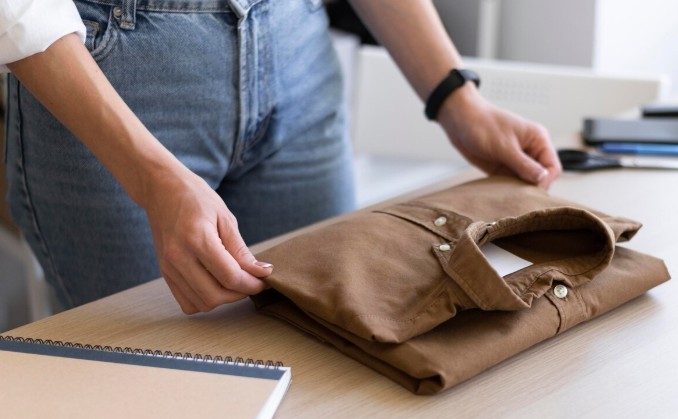
We’ve talked about how to start a clothing brand, but the essential part of any business is manufacturing your product. Whether you start off with a simple shirt brand idea or want to go bigger, all of this relies on how well you can communicate your ideas to the people making your apparel. We’ll be looking at some essential tips on how to work with clothing manufacturers, and what you can expect in the meantime.
Take note that many clothing brand owners don’t start with a good idea of how manufacturing works. This is something that can be easily fixed in time, but don’t let yourself believe the only thing you should be concerned about is design. Good design requires a solid knowledge of materials and stitches–something that your customers will appreciate over time.
Shirtual’s merchandising services also provide in-depth brand and material advice for new brand owners, in case you may feel overwhelmed. With that being said, here are the tips you’ll want to keep in mind when contacting your first manufacturer:
- Finalize your brand idea and business plans
Your manufacturer typically works with fabrics and not in business. They’ll give you options and advice, but ultimately, what choices you make depend entirely on your business strategy.
In general, you’ll want to already have a good idea of your target audience, market niche, brand identity, and marketing strategies. All of these things contribute to the design of your final product in one way or another, and we’ve talked about many ways to market and expand brand ideas.
Once you’ve understood the basics of your brand, you can let your manufacturer know what you’re about. They’ll sometimes give a good estimation of what you need, but the next step is important to keep their pace.
2. Research fabrics and garment manufacturing

If you recall the significance of buying high-quality fabric (as opposed to cheap material), you’ll understand why knowing what garment you’re working with is important. There’s a lot of ground to cover, but those who can tell the difference between cotton and polyester can go a long way.
Luckily for most modern brand owners, there are tons of resources to learn the difference between fabrics. As a taste of what to expect, though, here are just a few of the most common fabrics for merchandise brands:
- Polyester: One of the most common materials in merchandise, this synthetic material is durable and affordable. A good option for startups looking to lower costs, though the texture can be coarser on the skin.
- Cotton: There are many variations of cotton, such as cotton fleece, the expensive Pima cotton, and others. Cotton is also pretty common though somewhat more costly compared to polyester. In exchange, the material is much softer and allows for more creative, detailed prints.
- Linen: A breathable fabric that’s perfect for summer wear. However, it tends to be pricier than either cotton and polyester, and it creases rather easily.
- Jersey: A smooth-textured fabric that’s commonly found in more stretchable shirts.
Other than fabrics, you’ll want to keep track of manufacturing jargon. Just a few of them now: GSM decides the thickness of a fabric. Screen printing puts colors on a garment with film, whereas digital printing directly prints onto the fabric. Sublimation presses patterns onto fabrics and is ideal for polyester-heavy materials.
You’ll also have heard of a tech pack, which is the next important thing you want to prepare before going to a manufacturer. Let’s check it out!
3. Make simple tech packs

A tech pack is a more elaborate explanation of your product and what it will look like by the end. It typically includes a picture of your product from front to back, as well as significant details like measurements and fabric examples. You can check out a simple example of it here.
Your tech pack is essentially a blueprint for manufacturers to follow. Things can change from when you design the tech pack and when the actual product comes out, but it’s generally accepted that what’s on the tech pack papers will be in the final design. In other words, this is one of the best ways for you to communicate your vision with manufacturers.
When you’re starting out, it may be tempting to be ambitious and add novel designs to your tech pack. Unless you have a lot of experience in manufacturing, it’s best to keep your first tech packs as tame and simple as possible. Ambitious designs will require more reference pictures, more ideas for materials, and more sewing patterns over time.Once you’ve got the basics of your tech pack down, however, you can freely communicate more complex ideas to your manufacturer.
Now that you have your tech pack and material decided, it’s time to figure out how many products you need to sell in the first place.
4. Decide what MOQs you need

MOQs are a common standard in manufacturing that needs to be considered before sending your apparel to the printers. Often, it’s not enough to only order a few sheets of apparel for a short sale–manufacturers need to produce at least a hundred or so to take care of their costs. The specific amount is what we call minimum order quantities, or MOQs.
You may also be tempted to try producing apparel with smaller vendors that have low MOQs. While this can work out for the scale of your business, smaller vendors can also run the risk of lower or inconsistent quality of products.
Some merchandising services may be able to produce low amounts of MOQ at factory-level quality, however. Shirtual’s own MOQ can go as low as 40, whereas the industry standard tends to be at around 100. So if you’re interested in working with a manufacturer but uncertain about the costs to your business, you can start partnering with more elaborate merchandising services first.
5. Build connections with manufacturers

All good businesses are built on long-term, mutually beneficial relationships. This not only includes your client base, but your manufacturers, too! Once you’ve found an appropriate manufacturer, it’s good to stay loyal and keep contacting them regarding your productions. By their nature, merchandising and manufacturing services inherently have connections within the business, and can lead you to other good opportunities over time.
Shirtual’s own branding services provides exclusive insight into the manufacturing, production and distribution of apparel. If you’re still uncertain about your future with manufacturers, give us a call and we’ll help guide you through your new venture.






